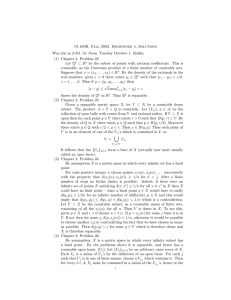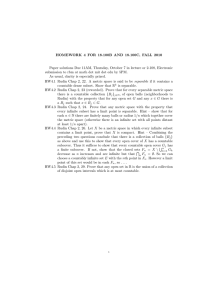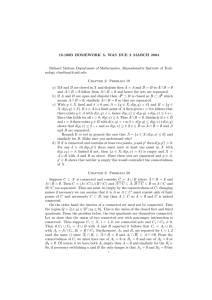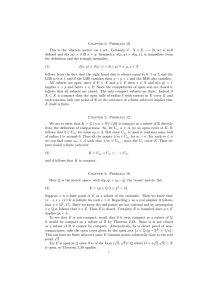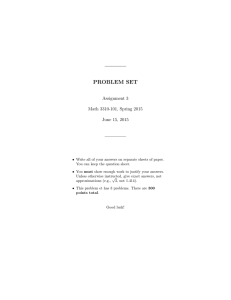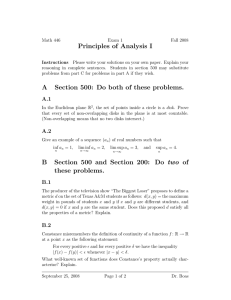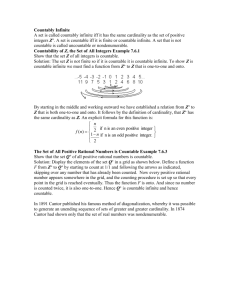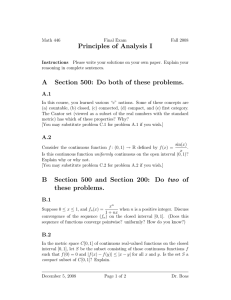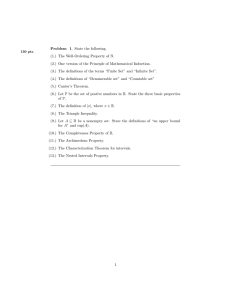HOMEWORK 4 FOR 18.100B AND 18.100C, FALL 2010 SOLUTIONS, SOMEWHAT WORDY.
advertisement
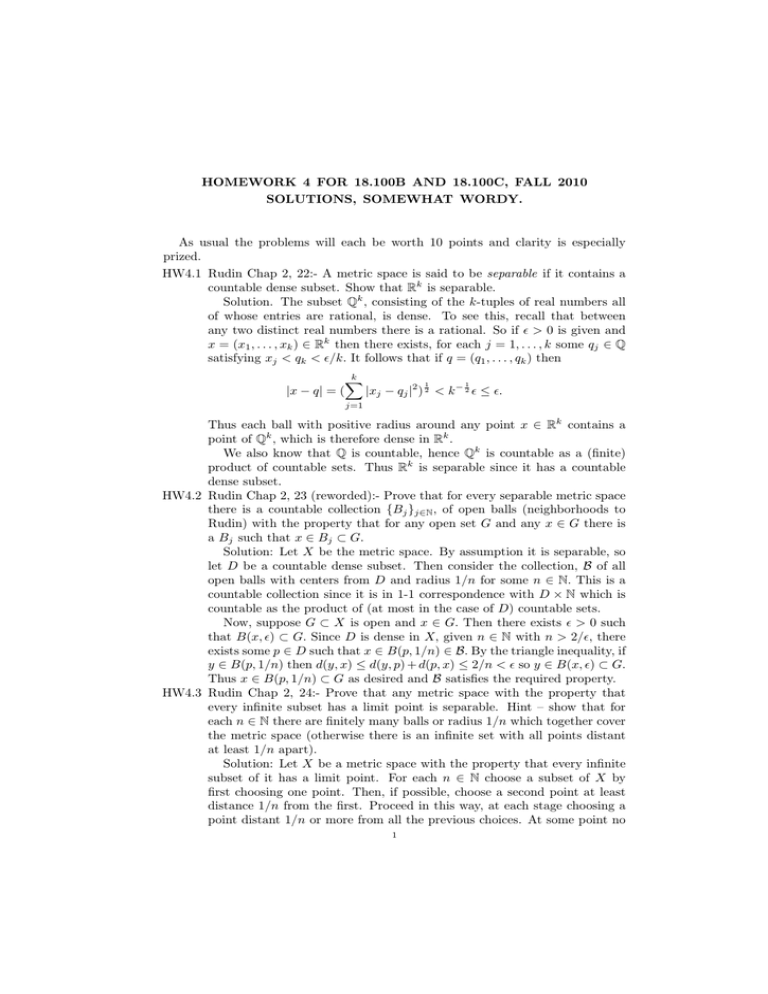
HOMEWORK 4 FOR 18.100B AND 18.100C, FALL 2010
SOLUTIONS, SOMEWHAT WORDY.
As usual the problems will each be worth 10 points and clarity is especially
prized.
HW4.1 Rudin Chap 2, 22:- A metric space is said to be separable if it contains a
countable dense subset. Show that Rk is separable.
Solution. The subset Qk , consisting of the k-tuples of real numbers all
of whose entries are rational, is dense. To see this, recall that between
any two distinct real numbers there is a rational. So if > 0 is given and
x = (x1 , . . . , xk ) ∈ Rk then there exists, for each j = 1, . . . , k some qj ∈ Q
satisfying xj < qk < /k. It follows that if q = (q1 , . . . , qk ) then
k
X
1
1
|x − q| = (
|xj − qj |2 ) 2 < k − 2 ≤ .
j=1
Thus each ball with positive radius around any point x ∈ Rk contains a
point of Qk , which is therefore dense in Rk .
We also know that Q is countable, hence Qk is countable as a (finite)
product of countable sets. Thus Rk is separable since it has a countable
dense subset.
HW4.2 Rudin Chap 2, 23 (reworded):- Prove that for every separable metric space
there is a countable collection {Bj }j∈N , of open balls (neighborhoods to
Rudin) with the property that for any open set G and any x ∈ G there is
a Bj such that x ∈ Bj ⊂ G.
Solution: Let X be the metric space. By assumption it is separable, so
let D be a countable dense subset. Then consider the collection, B of all
open balls with centers from D and radius 1/n for some n ∈ N. This is a
countable collection since it is in 1-1 correspondence with D × N which is
countable as the product of (at most in the case of D) countable sets.
Now, suppose G ⊂ X is open and x ∈ G. Then there exists > 0 such
that B(x, ) ⊂ G. Since D is dense in X, given n ∈ N with n > 2/, there
exists some p ∈ D such that x ∈ B(p, 1/n) ∈ B. By the triangle inequality, if
y ∈ B(p, 1/n) then d(y, x) ≤ d(y, p) + d(p, x) ≤ 2/n < so y ∈ B(x, ) ⊂ G.
Thus x ∈ B(p, 1/n) ⊂ G as desired and B satisfies the required property.
HW4.3 Rudin Chap 2, 24:- Prove that any metric space with the property that
every infinite subset has a limit point is separable. Hint – show that for
each n ∈ N there are finitely many balls or radius 1/n which together cover
the metric space (otherwise there is an infinite set with all points distant
at least 1/n apart).
Solution: Let X be a metric space with the property that every infinite
subset of it has a limit point. For each n ∈ N choose a subset of X by
first choosing one point. Then, if possible, choose a second point at least
distance 1/n from the first. Proceed in this way, at each stage choosing a
point distant 1/n or more from all the previous choices. At some point no
1
2 HOMEWORK 4 FOR 18.100B AND 18.100C, FALL 2010 SOLUTIONS, SOMEWHAT WORDY.
further choices are possible since a set with all points distant at least 1/n
from each other cannot have a limit point, so an infinite number of such
choices in X is not possible. Thus, for each n this procedure gives a finite
set such that the balls of radius 1/n with elements of this set as centers
covers X. The union of these finite sets is a(n at most) countable set which
is dense in X since for every x ∈ X and every > 0 one can choose n > 1/
and then there is a point in the set distant at most 1/n < from x.
HW4.4 Rudin Chap 2, 26. Let X be a metric space in which every infinite subset
contains a limit point, prove that X is compact. Hint – Combining the
preceding two questions conclude that there is a collection of balls {Bj }
as above and use this to show that every open cover of X has a countable
subcover. Thus it suffices to show that every countable open
Sn cover Gj has a
finite subcover. If not, show that the closed
sets
F
=
X
\
n
k=1 Gk decrease
T
as n increases and are infinite but that n Fn = ∅. So we can choose a
countably infinite set E with the nth point in Fn . However a limit point of
this set would be in each Fn , so . . . .
Solution: If X is a metric space in which every infinite set has a limit
point, we know that X is separable by the preceding problem. Then choose
a countable collection of balls B as HW4.2. Now, given an open cover Gα
of X for each x ∈ X there is a B ∈ B such that x ∈ B ⊂ Gα for some α.
For each B ∈ B either choose an α such that B ⊂ Gα , if there is one, or
else do nothing. This determines an at most countable subcover of the Gα
since every x ∈ X is contained in one of the balls which are contained in a
Gα .
Thus, we can consider a countable subcover Gj – if it is finite we are
already done. The sets
Fn = X \ (
n
[
Gj )
j=1
are closed, as the complements
T of open sets, and decrease with n. To say
that the Gj cover is to say n Fn = ∅. Suppose that no Fn is empty. Then
we can choose a subset E of X by choosing successive elements xn ∈ Fn .
This set must be infinite, since if it were finite we must have made the
same choice infinitely often,Tand since the Fn are getting smaller this would
mean there was a point in n Fn . Thus, E must have a limit point. Now,
for each n all but a finite number of points of E are in Fn thus the limit
point must also be a limit point of E ∩ Fn for each n. Hence, since they are
closed,
it must be in Fn for each n. Thus, again, we have found a point in
T
F
so
n
n
Sn the assumption that each Fn is non-empty must be false. Hence
X = j=1 Gj for some n so Gj does indeed have a finite subcover. Thus
X is compact since it has the property that every open cover has a finite
subcover.
HW4.5 Rudin Chap 2, 29. Prove that any open set in R is the union of a collection
of pairwise disjoint open intervals which is at most countable. Note – the
pairwise was added afterwards, since a few people were confused by the
meaning of ‘disjoint’ otherwise.
Solution: Observe that the union of any collection of open intervals which
all contain a common point is an open interval (possibly infinite) with end
HOMEWORK 4 FOR 18.100B AND 18.100C, FALL 2010 SOLUTIONS, SOMEWHAT WORDY. 3
points the infimum of the lower end points (if this set is not bounded below
then −∞) or supremum of the upper end points (or +∞ if this set is not
bounded above). Now, take a point in O ∩ Q and consider the union of
all the open intervals which contain it and are contained in O. Then, if
possible, select a point in O ∩ Q which is not in this first interval and
proceed. This constructs an at most countable collection of intervals which
are contained in O and together cover it. They must be disjoint since if two
have non-empty intersection the union is an interval which would contain
any point in either, so must be equal to the first.
